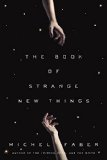Book Club Discussion Questions
In a book club? Subscribe to our Book Club Newsletter!
For supplemental discussion material see our Beyond the Book article, Michel Faber and our BookBrowse Review of The Book of Strange New Things.
Please be aware that this discussion guide will contain spoilers!
- The Book of Strange New Things is a literary novel with elements of science fiction. Do you consider it more one genre than the other? Does it fall into any other categories?
- Peter and Bea's marriage is at the heart of The Book of Strange New Things. How does the evolution of their relationship help drive the action of the book? Do you think their letters reveal the full breadth of their experiences apart?
- While Peter is away ministering to the Oasans, Bea's world is torn by calamity. As Peter struggles to remain connected to her, he is challenged by both their physical and emotional distance. Do you think he overcomes this?
- The Book of Strange New Things raises significant questions about our ability to feel compassion towards others, from strangers to those we love most deeply. How does Peter's ability to show empathy change throughout the novel?
- Peter's coworkers on the USIC compound were chosen for the mission based on certain professional and psychological qualifications. What were these attributes, and does Peter share them?
Peter holds himself to a high ethical standard in both his marriage and his religious faith. How does this mission test his loyalty to both?
- Before his religious epiphany, Peter was a drug addict and an alcoholic. After becoming a Christian, he channels these propensities into a singular focus on his faith. Could Peter's religious dedication be another form of addiction?
- Peter agrees to minister to the Oasans without having ever met them. How would you describe them as a group? Were they what you expected?
- In Bea's absence, Peter forms an emotional connection with his coworker, Alex Grainger. Is their developing friendship a threat to Peter's relationship with Bea? Why or why not?
- The Book of Strange New Things explores a variety of wide-ranging themes: love, fidelity, faith, and compassion. Of these, which do you think this book is ultimately about?
Unless otherwise stated, this discussion guide is reprinted with the permission of Hogarth Books.
Any page references refer to a USA edition of the book, usually the trade paperback version, and may vary in other editions.
